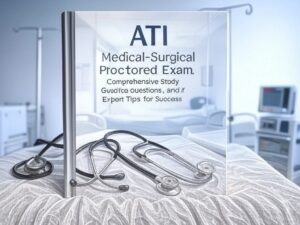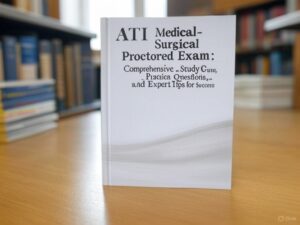Prepare effectively for the ATI Medical-Surgical Proctored Exam with this comprehensive study guide, designed to support nursing students in achieving success. This resource includes a wide range of practice questions covering key medical-surgical nursing topics such as cardiovascular, respiratory, gastrointestinal, endocrine, and neurological disorders, alongside perioperative care and emergency nursing. Each question is complemented by detailed explanations to clarify complex concepts and strengthen clinical understanding. Additionally, expert tips for success provide strategic advice on test preparation, time management, and critical thinking to enhance exam performance. Aligned with the latest ATI Med-Surg content standards, this guide incorporates evidence-based practices and NCLEX-style questions to ensure well-rounded readiness. Ideal for nursing students aiming to excel in their med-surg coursework and proctored exams, this study guide is a crucial resource for academic and professional growth.
Preview
1. A nurse in an emergency department is preparing to perform ocular irrigation for a
client. Which of the following actions should the nurse plan to take?
a. Assess the client’s visual acuity prior to irrigation
b. Have the client turn their head toward the unaffected eye
c. Hold the irrigator syringe 3.81 cm (1.5 in) above the eye
d. Perform the irrigation with sterile water for irrigation (Correct Answer: d)
Rationale: Sterile water is used for irrigation to flush out any contaminants while
minimizing infection risk. Other options are incorrect because assessing visual acuity
should be done after irrigation, the head should be turned toward the affected eye to
prevent contamination of the other eye, and the irrigator syringe should be held at a safe
distance but not a fixed measurement.
2. A nurse is preparing to administer Lactated Ringer’s via continuous IV infusion at
200 mL/hr. The IV tubing has a drop factor of 10 drops/mL. How many gtt/min should
the nurse set the IV pump to administer?
(Correct Answer: 33 gtt/min)
Rationale: Using the formula:
Flow Rate=(Volume (mL/hr)×Drop Factor (gtt/mL)60 min/hr)\text{Flow Rate} = \left(
\frac{\text{Volume (mL/hr)} \times \text{Drop Factor (gtt/mL)}}{60 \text{ min/hr}} \right)
=(200×1060)=33.3≈33gtt/min= \left( \frac{200 \times 10}{60} \right) = 33.3 \approx 33
gtt/min
3. A nurse is providing discharge teaching to a client who has a new prescription for
sublingual nitroglycerin. Which of the following client statements indicates an
understanding of the teaching?
a. I can keep my medication for 1 year before replacing it
b. I should lie down when I take this medication (Correct Answer: b)
c. I should discontinue this medication if I develop a headache
d. I can take up to five tablets in 15 minutes before seeking medical attention
Rationale: Lying down can help prevent dizziness and hypotension, which are common
side effects of nitroglycerin. The medication should be replaced every 6 months, not a year.
A headache is a common side effect and does not warrant discontinuation. The maximum
dose is three tablets in 15 minutes, not five.
4. A nurse is providing discharge teaching to an older adult client following a left total
hip arthroplasty. Which of the following instructions should the nurse include in the
teaching?
a. Clean the incision daily with hydrogen peroxide
b. You can cross your legs at the ankles when sitting down
c. You should use an incentive spirometer every 8 hours
d. Install a raised toilet seat in your bathroom (Correct Answer: d)
Rationale: A raised toilet seat prevents excessive hip flexion, reducing the risk of hip
dislocation. Hydrogen peroxide should not be used as it delays wound healing. Clients
should avoid crossing their legs, as it can lead to hip dislocation. An incentive spirometer
should be used every 1-2 hours while awake, not every 8 hours.
client. Which of the following actions should the nurse plan to take?
a. Assess the client’s visual acuity prior to irrigation
b. Have the client turn their head toward the unaffected eye
c. Hold the irrigator syringe 3.81 cm (1.5 in) above the eye
d. Perform the irrigation with sterile water for irrigation (Correct Answer: d)
Rationale: Sterile water is used for irrigation to flush out any contaminants while
minimizing infection risk. Other options are incorrect because assessing visual acuity
should be done after irrigation, the head should be turned toward the affected eye to
prevent contamination of the other eye, and the irrigator syringe should be held at a safe
distance but not a fixed measurement.
2. A nurse is preparing to administer Lactated Ringer’s via continuous IV infusion at
200 mL/hr. The IV tubing has a drop factor of 10 drops/mL. How many gtt/min should
the nurse set the IV pump to administer?
(Correct Answer: 33 gtt/min)
Rationale: Using the formula:
Flow Rate=(Volume (mL/hr)×Drop Factor (gtt/mL)60 min/hr)\text{Flow Rate} = \left(
\frac{\text{Volume (mL/hr)} \times \text{Drop Factor (gtt/mL)}}{60 \text{ min/hr}} \right)
=(200×1060)=33.3≈33gtt/min= \left( \frac{200 \times 10}{60} \right) = 33.3 \approx 33
gtt/min
3. A nurse is providing discharge teaching to a client who has a new prescription for
sublingual nitroglycerin. Which of the following client statements indicates an
understanding of the teaching?
a. I can keep my medication for 1 year before replacing it
b. I should lie down when I take this medication (Correct Answer: b)
c. I should discontinue this medication if I develop a headache
d. I can take up to five tablets in 15 minutes before seeking medical attention
Rationale: Lying down can help prevent dizziness and hypotension, which are common
side effects of nitroglycerin. The medication should be replaced every 6 months, not a year.
A headache is a common side effect and does not warrant discontinuation. The maximum
dose is three tablets in 15 minutes, not five.
4. A nurse is providing discharge teaching to an older adult client following a left total
hip arthroplasty. Which of the following instructions should the nurse include in the
teaching?
a. Clean the incision daily with hydrogen peroxide
b. You can cross your legs at the ankles when sitting down
c. You should use an incentive spirometer every 8 hours
d. Install a raised toilet seat in your bathroom (Correct Answer: d)
Rationale: A raised toilet seat prevents excessive hip flexion, reducing the risk of hip
dislocation. Hydrogen peroxide should not be used as it delays wound healing. Clients
should avoid crossing their legs, as it can lead to hip dislocation. An incentive spirometer
should be used every 1-2 hours while awake, not every 8 hours.












Reviews
There are no reviews yet.